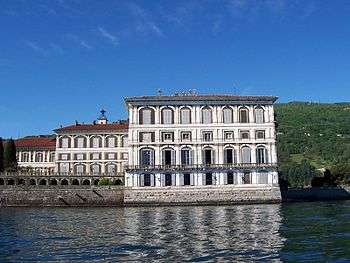Stresa Front

Coordinates: 45°53′47.1″N 8°31′33.6″E / 45.896417°N 8.526000°E The Stresa Front, formally called the Final Declaration of the Stresa Conference, was an agreement made in Stresa, a town on the banks of Lake Maggiore in Italy, between French Prime Minister Pierre Laval, British Prime Minister Ramsay MacDonald, and Italian Prime Minister Benito Mussolini on April 14, 1935. Its aims were to reaffirm the Locarno Treaties, to declare that the independence of Austria "would continue to inspire their common policy" and to resist any future attempt by the Germans to change the Treaty of Versailles.
The Stresa Front began to break down after the United Kingdom signed the Anglo-German Naval Agreement in June 1935 in which Germany was given permission to increase the size of its navy. The Stresa Front broke down completely two months later, after the Italian invasion of Abyssinia in October 1935.
Background
The Stresa Front was triggered by Nazi Germany's declaration of its intention to build up an air force, increase the size of its army to 36 divisions (500,000 men) and introduce conscription, in March 1935. All of the actions were direct violations of the Treaty of Versailles, which limited the size of the German Army to 100,000 men, forbade conscription in Germany and prohibited a German air force.
Mussolini thought that the signing of the Stresa Front would mean that the United Kingdom and France would not interfere during the Abyssinia crisis.
Conference

Even though the increasingly-belligerent Germany dominated discussions within the conference room, Mussolini was more clever outside it. With Britain, he discussed plans to pursue his aim of making Italy 'great, respected and feared' by the invasion and conquest of the Abyssinian Empire and creating an all-powerful empire. Mussolini made sure not to discuss his expansionist plans during the conference itself, as he knew of the risk of Western democracies rejecting. Furthermore, Mussolini did not want to risk the conference being sidetracked from its main aims of reaffirming Locarno and opposing any more breaches of international agreements.
Mussolini got his way, and his plans to invade Abyssinia were not brought up. He took that silence as acquiescence to his colonial war and so he launched his invasion of Abyssinia in October 1935. That was the turning point for Mussolini, as he later drifted away from Britain and France and toward Germany.
Assessment
In April 1935, the United Kingdom, Italy and France reaffirmed the Treaty of Locarno and agreed to form the Stresa Front to combat and contain Germany.
Soon after Stresa, on June 18th 1935,... Great Britain signed a naval agreement with them and without informing neither France nor Italy, which put a direct proportion to Germany and Britain by number and tonnage of warships, in fact renegading the agreements of Stresa, as well as those of Versailles of 1919. Benito Mussolini was furious when he heard the news and, unfortunately for Italy, convinced himself that Hitler couldn't be stopped anymore and that, therefore, he had to ride the tiger. – John Simon[1]
The Stresa Front could be seen as a failure because it had vague terms, and it was not clear how its aims should be upheld. It had no reference to Germany, as Britain was adopting a dual policy and did not want to antagonise Hitler. The hard line was provided by Mussolini, but Britain 'kept the door open' with Germany to obtain agreements. Hitler had used tactics that made Britain and France guess his next move.
However, the vague terms of the agreement kept Hitler guessing what Britain would do. Britain failed to realise its advantage over Germany and lost it after the Anglo-German Naval Agreement.
Another reason for the agreement's failure was that Britain, France and Italy did not want to invade Germany, but a full-scale invasion of Germany would have been necessary to cease its rearmament. The British government was unwilling to do so because of the strongly-antiwar British public.
The Anglo-German Naval Agreement allowed Germany to increase the size of its navy to 35% by tonnage of the Royal Navy and to build submarines. The British government had not discussed it with its Stresa partners. The members of the Stresa Front were then pulling in different directions.
Dissolution
The front collapsed completely after the Italian invasion of Abyssinia.
Mussolini had long wanted to control Abyssinia and was enraged by the signing of the Anglo-German Naval Agreement without prior notice.[2] He had held back on his invasion plans to avoid alienating his allies, especially since Ethiopia bordered French Somaliland and British Somaliland. However, he felt betrayed by Britain and so decided that there was no longer any reason against the invasion. He also believed that the agreement violated the Stresa Front.
For the French, the Anglo-German Naval Agreement was an "offense" to World War I victory agreements. Indeed, the Naval Pact was signed in London on June 18, 1935 without the British government even informing France and Italy. Also, they were not told of the secret agreements that allowed the Germans to build in certain categories more-powerful warships than any of the three Western nations had possessed. The French regarded that as "treachery" and saw it as a further appeasement of Hitler, whose appetite grew with concessions. They believed for that the British agreed for a private gain to scrap the peace treaty further, which would add to the growing overall military power of Nazi Germany. The British, according to France, had no legal right to absolve Germany of its obligation to respect the naval clauses of the Versailles Treaty.[3]
On January 6, 1936, Mussolini told German Ambassador Ulrich von Hassell that he would not object to Germany taking Austria as a satellite state if Austria maintained its formal independence. On 22 February, Mussolini then agreed to Hitler's remilitarization of the Rhineland and stated that Italy would not honour the Locarno Treaty if that occurred.[4]
In Italy and France, the Stresa Conference is considered the last tentative to stop Hitler and to block World War II.[5]
See also
- Anschluss, the annexation of Austria by Germany in 1938
References
- ↑ 80 Years anniversary of Stresa Comference
- ↑ Richard Lamb. Mussolini as Diplomat: Il Duce's Italy on the World Stage, pg. 114
- ↑ William Shirer. The Collapse of the Third Republic: An Inquiry into the Fall of France in 1940; p.249,250
- ↑ Peter Neville. Mussolini, pg. 135
- ↑ Stresa conference: tentative to stop Hitler's wars (in Italian)